The long-living piston-powered legend
Although some of the most prominent WW2 aircraft, such as the F4U Corsair or the P51 Mustang, constantly upgraded, still took part in various combats in the 1970-80s, the Douglas Skyraider is certainly one of these surprises. Known at first as the AD Skyraide this very robust and reliable single-seat attack aircraft was in service from 1946, virtually to the early 1980s, making a remarkably long and successful career for a piston-engined model in turboprop and jet age. For these longevity reasons it was also nicknamed lately the "Spad", a reference to the French WWI fighter. In the 1960s indeed when it soldiered over Vietnam, there was as much time since its first flight from the Spads in US service.⚠ Note: This post is in writing. Completion expected in 2024.
In any case, its probably these old school recipes which allowed this venerable "bomb truck" to see so much active service for decades, until the early 1970s in the US Navy and marines alone. Cheap and simple to maintain, requiring a single pilot as crew, extraordinarily resilient, this dependable beast of burden flew the most perilous missions deep in enemy territory and almost always came back to tell the tale. Inspirational, it was never replaced by the small A4 Skyhawk, but it's only worthy successor, the legendary A10 Warthog, which went to the USAAF while officially the Navy replaced it by the Vought A7 Corsair II. The "A" standing for attack, was also the reset of this peacetime designation, and it was the first to inaugurate this new line.
Birth of a legend (1943)
 In 1943 an official requirement was published for a carrier-based attack aircraft, single-seat, long-range, and high performance model capable of acting as dive and torpedo bomber. It was supposed to replace the Douglas SBD Dauntless, the Curtiss SB2C Helldiver and the Grumman TBF Avenger as a "universal platform". The single pilot was now possible by using more automated systems, radar, and better radios. The famous specification, also looked forward in UK, trigerred a whole generation of competitors, among which was the Martin AM Mauler and the Grumman AF Guardian. Both were far less successful and only built in small numbers despite more promising features.
In 1943 an official requirement was published for a carrier-based attack aircraft, single-seat, long-range, and high performance model capable of acting as dive and torpedo bomber. It was supposed to replace the Douglas SBD Dauntless, the Curtiss SB2C Helldiver and the Grumman TBF Avenger as a "universal platform". The single pilot was now possible by using more automated systems, radar, and better radios. The famous specification, also looked forward in UK, trigerred a whole generation of competitors, among which was the Martin AM Mauler and the Grumman AF Guardian. Both were far less successful and only built in small numbers despite more promising features.
Douglas, which already provided the Dauntless to the USN, was equal favorite in a competition in which many great manufacturers competed for a potentially still very lucrative market postwar. The Douglas XBT2D as first designated was Designed by Ed Heinemann of the Douglas Aircraft Company and submitted in early 1944. Accepted, it was followed by an order of a few prototypes on 6 July 1944 as the XBT2D-1. In seven month, the prototype was built and tested at Douglas, making its first flight on 18 March 1945, showing only heatlhy characteristics and practicaly no serious fixes were done. This was followed logically by official tests at the Naval Air Test Center (NATC) in April 1945.
With less emeregency due to the end of the war in Europe and a situation stabilized in the Pacific, tests and fixes dragged on until December 1946, and its designation was changed to the postwar "AD-1", "A" standard for "attack" and "D" for the manufacturer, Douglas. On order was made for a first batch a delivery to the first fleet squadron was made to VA-19A in early 1947. Needless to say, this model, although designed duting WW2, never fought. Production of the AD-1 was setup at Douglas's El Segundo plant, Southern California, where the Dauntless was built in the past. Certifying AD-1s out of the assembly line wad made at a rate of two aircraft per day between 1949 and 1950.
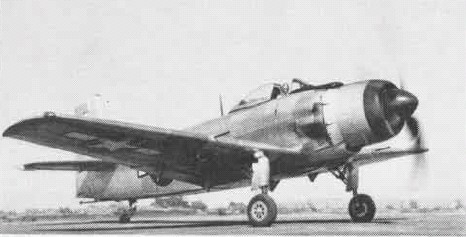
Photo: The first XBT2D-1 tested at NATC in April 1945.
Design of the Douglas AD Skyraider
(To come)⚒ specifications AD-1 1945 | |
| Dimensions (L-w-h): | 38 ft 10 in x 50 ft 0.25 in x 15 ft 8.25 in (11.84 x 15.24 x 4.78 m) |
| Wing area: | 400.33 sq ft (37.192 m2) |
| Airfoil: | root: NACA 2417; tip: NACA 4413 |
| Weight, empty | 11,968 lb (5,429 kg) |
| Weight, gross | 18,106 lb (8,213 kg) |
| Fuel Capacity: | 380 US gal (320 imp gal; 1,400 l) internal tanks |
| Propulsion | Wright R-3350-26WA Duplex-Cyclone 18-cyl ACRPE, 2,700 hp (2,000 kW) |
| Propeller | 4-bladed Aeroproducts constant-speed propeller |
| Speed, max. | 322 mph (518 km/h, 280 kn) at 18,000 ft (5,500 m) |
| Ceiling | 28,500 ft (8,700 m) |
| Climb Rate | 2,850 ft/min (14.5 m/s) |
| Range | 1,316 mi (2,118 km, 1,144 nmi) |
| Wing load | 46.6 lb/sq ft (228 kg/m2) |
| Power/mass | 0.149 hp/lb (0.245 kW/kg) |
| Armament: MGs | 4x 20 mm AN/M3 cannon with 200 rounds per gun |
| Armament: Payload | 15 external hardpoints, 8,000 lb (3,600 kg), see notes |
| Crew: | 1 pilot |
Gallery:

AD-1 of VA3B, USS Franklin D. Roosevelt, 1948

AD-1 of VA-1L, USS Saipan, 1948
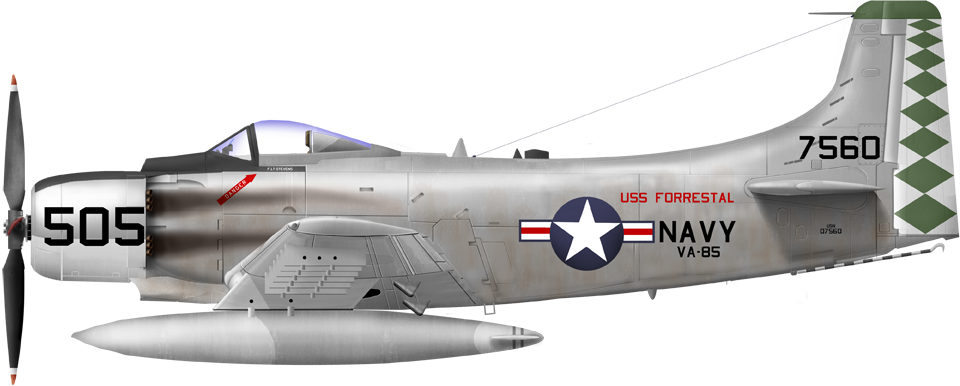
AD-1 of VA-85, USS Forrestal, 1958
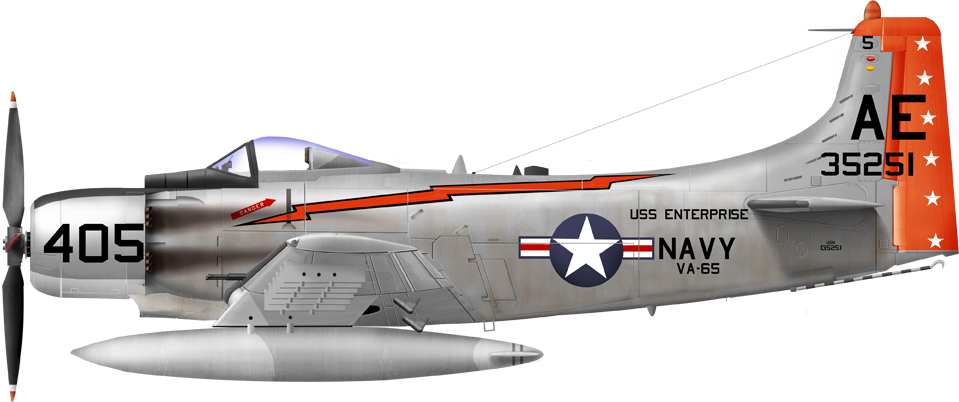
AH-1 Skyraider, VA-65, USS Enterprise, 1960
(Much, much more to come)


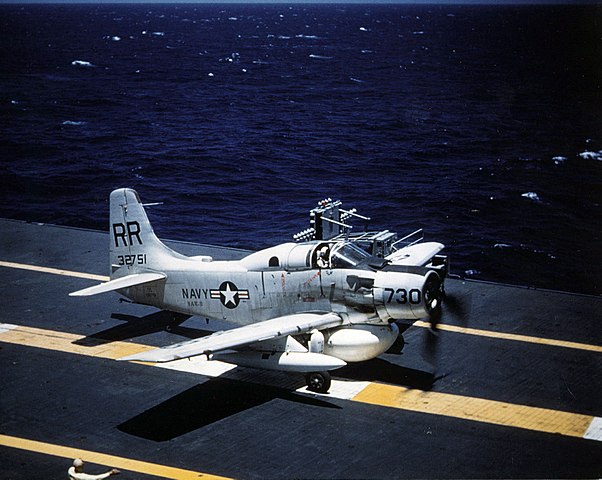


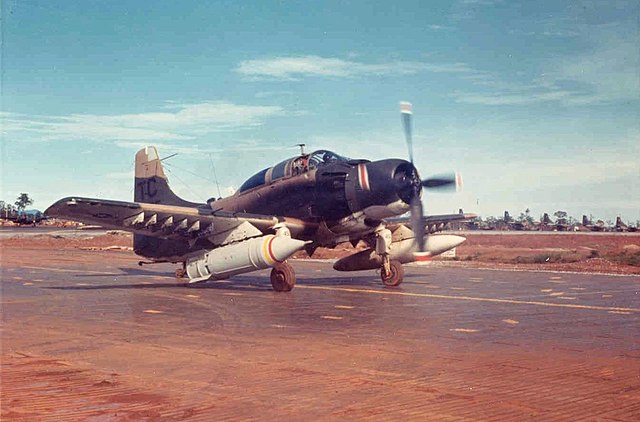
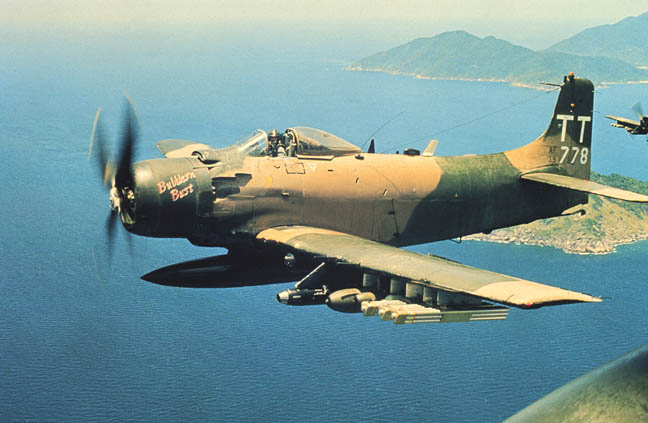
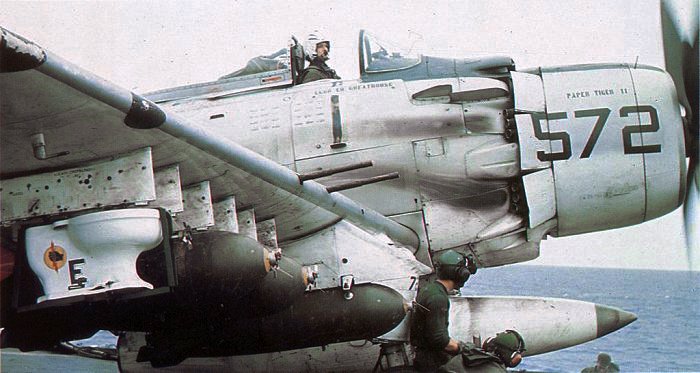
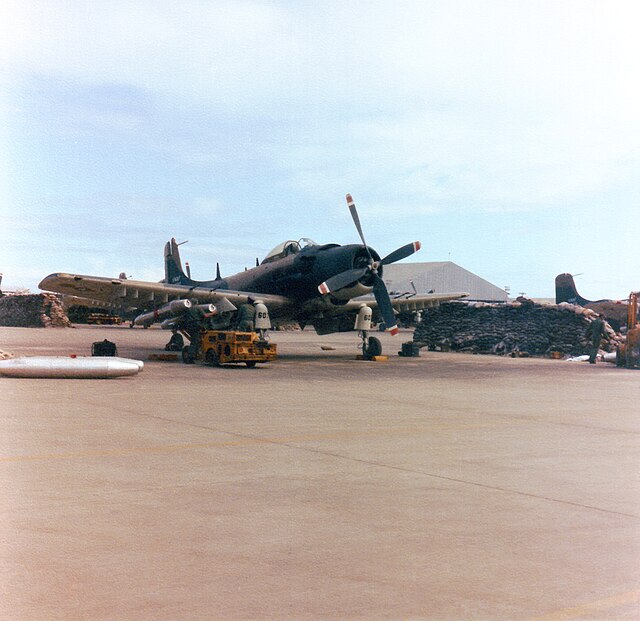
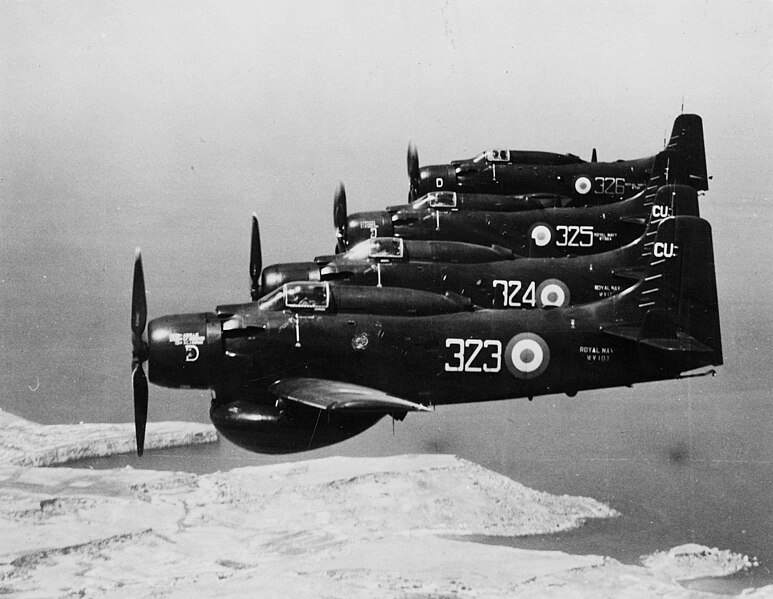

AD-1 of VA3B, USS Franklin D. Roosevelt, 1948

AD-1 of VA-1L, USS Saipan, 1948

AD-1 of VA-85, USS Forrestal, 1958

AH-1 Skyraider, VA-65, USS Enterprise, 1960
(Much, much more to come)
Photos










Src/Read more about the AD Skyraider:
The Models Corner:
- Lohner E (1913)
- Macchi M3 (1916)
- Macchi M5 (1918)
- Ansaldo ISVA (1918)
- Sopwith Baby (1916)
- Short 184 (1916)
- Fairey Campania (1917)
- Sopwith Cuckoo (1917)
- Felixstowe F.2 (1917)
- Friedrichshafen FF 33 (1916)
- Albatros W4 (1916)
- Albatros W8 (1918)
- Hanriot HD.2
- Grigorovitch M5
- IJN Farman MF.7
- IJN Yokosho Type Mo
- Yokosho Rogou Kougata (1917)
- Yokosuka Igo-Ko (1920)
- Curtiss N9 (1916)
- Aeromarine 39
- Vought VE-7
- Douglas DT (1921)
- Boeing FB.5 (1923)
- Boeing F4B (1928)
- Vought O2U/O3U Corsair (1928)
- Blackburn Blackburn (1922)
- Supermarine Seagull (1922)
- Blackburn Ripon (1926)
- Fairey IIIF (1927)
- Fairey Seal (1930)
- LGL-32 C.1 (1927)
- Caspar U1 (1921)
- Dornier Do J Wal (1922)
- Rohrbach R-III (1924)
- Mitsubishi 1MF (1923)
- Mitsubishi B1M (1923)
- Yokosuka E1Y (1923)
- Nakajima A1N (1927)
- Nakajima E2N (1927)
- Mitsubishi B2M (1927)
- Nakajima A4N (1929)
- CANT 18
WW1
✠ K.u.K. Seefliegerkorps:
 Italian Naval Aviation
Italian Naval Aviation
 RNAS
RNAS
 Marineflieger
Marineflieger
 French Naval Aviation
French Naval Aviation
 Russian Naval Aviation
Russian Naval Aviation
 IJN Air Service
IJN Air Service
 USA
USA
Interwar
 Interwar US
Interwar US
 Interwar Britain
Interwar Britain
 Interwar France
Interwar France
 Interwar Germany
Interwar Germany
 Interwar Japan
Interwar Japan
 Interwar Italy
Interwar Italy
- Curtiss SOC seagull (1934)
- Grumman FF (1931)
- Curtiss F11C Goshawk (1932)
- Grumman F2F (1933)
- Grumman F3F (1935)
- Northrop BT-1 (1935)
- Grumman J2F Duck (1936)
- Consolidated PBY Catalina (1935)
- Brewster/NAF SBN-1 (1936)
- Curtiss SBC Helldiver (1936)
- Vought SB2U Vindicator (1936)
- Brewster F2A Buffalo (1937)
- Douglas TBD Devastator (1937)
- Vought Kingfisher (1938)
- Curtiss SO3C Seamew (1939)
- Douglas SBD Dauntless (1939)
- Grumman F4F Wildcat (1940)
- F4U Corsair (NE) (1940)
- Brewster SB2A Buccaneer (1941)
- Grumman TBF/TBM Avenger (1941)
- Consolidated TBY Sea Wolf (1941)
- Grumman F6F Hellcat (1942)
- Curtiss SB2C Helldiver (1942)
- Curtiss SC Seahawk (1944)
- Grumman F8F Bearcat (1944)
- Ryan FR-1 Fireball (1944)
- Douglas AD-1 Skyraider (1945)
Fleet Air Arm
- Fairey Swordfish (1934)
- Blackburn Shark (1934)
- Supermarine Walrus (1936)
- Fairey Seafox (1936)
- Blackburn Skua (1937)
- Short Sunderland (1937)
- Blackburn Roc (1938)
- Fairey Albacore (1940)
- Fairey Fulmar (1940)
- Grumman Martlet (1941)
- Hawker sea Hurricane (1941)
- Brewster Bermuda (1942)
- Fairey Barracuda (1943)
- Fairey Firefly (1943)
- Grumman Tarpon (1943)
- Grumman Gannet (1943)
- Supermarine seafire (1943)
- Blackburn Firebrand (1944)
- Hawker Sea Fury (1944)
IJN aviation
- Aichi D1A "Susie" (1934)
- Mitsubishi A5M "Claude" (1935)
- Nakajima A4N (1935)
- Yokosuka B4Y "Jean" (1935)
- Mitsubishi G3M "Nell" (1935)
- Nakajima E8N "Dave" (1935)
- Kawanishi E7K "Alf" (1935)
- Nakajima B5N "Kate" (1937)
- Kawanishi H6K "Mavis" (1938)
- Aichi D3A "Val" (1940)
- Mitsubishi A6M "zeke" (1940)
- Nakajima E14Y "Glen" (1941)
- Nakajima B6N "Jill" (1941)
- Mitsubishi F1M "pete" (1941)
- Aichi E13A Reisu "Jake" (1941)
- Kawanishi E15K Shiun "Norm" (1941)
- Nakajima C6N Saiun "Myrt" (1942)
- Yokosuka D4Y "Judy" (1942)
- Kyushu Q1W Tokai "Lorna" (1944)
Luftwaffe
- Arado 196 (1937)
- Me109 T (1938)
- Blohm & Voss 138 Seedrache (1940)
Italian Aviation
- Savoia-Marchetti S.55
- IMAM Ro.43/44
- CANT Z.501 Gabbiano
- CANT Z.506 Airone
- CANT Z.508
- CANT Z.511
French Aeronavale
- GL.300 (1926-39)
- Levasseur PL.5 (1927)
- Potez 452 (1935)
- Loire 210 (1936)
- Loire 130 (1937)
- LN 401 (1938)
Soviet Naval Aviation
- Shavrov SH-2 (1928)
- Tupolev TB-1P (1931)
- Beriev MBR-2 (1930)
- Tupolev MR-6 (1933)
- Tupolev MTB-1 (1934)
- Beriev Be-2 (1936)
- Polikarpov I16 naval (1936)
- Tupolev MTB-2 (1937)
- Ilyushine DB-3T/TP (1937)
- Beriev Be-4 (1940)
-
Skoda Š-328V
R-XIII Idro
Fokker C.XI W (1934)
WW2
- De Havilland Sea Vixen
- Hawker Sea Hawk
- Supermarine Scimitar
- Blackburn Buccaneer
- Hawker Sea Harrier
- Douglas A4 Skyhawk
- Grumman F9F Panther
- Vought F8 Crusader
- McDonnell-Douglas F-4 Phantom-II
- North Am. A5 Vigilante
- TU-142
- Yak 38 forger
☢ Cold War
✧ NATO
 Fleet Air Arm
Fleet Air Arm
 US Navy
US Navy
☭ Warsaw Pact
Merch

Seafire Mark 45; HMS Pretoria Castle

Zeros vs its aversaries

Aichi D3A “Val” Junyo

Mitsubishi A5M poster

F4F wildcat

Macchi M5

SBD Dauntless Coral Sea

SBD Dauntless USS Enterprise

SBD-4 CV22